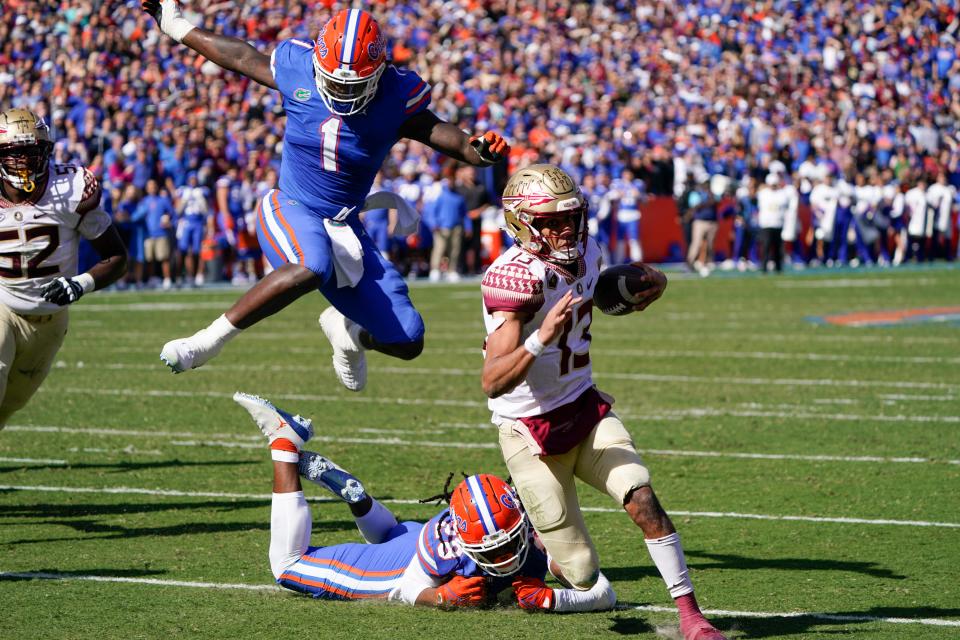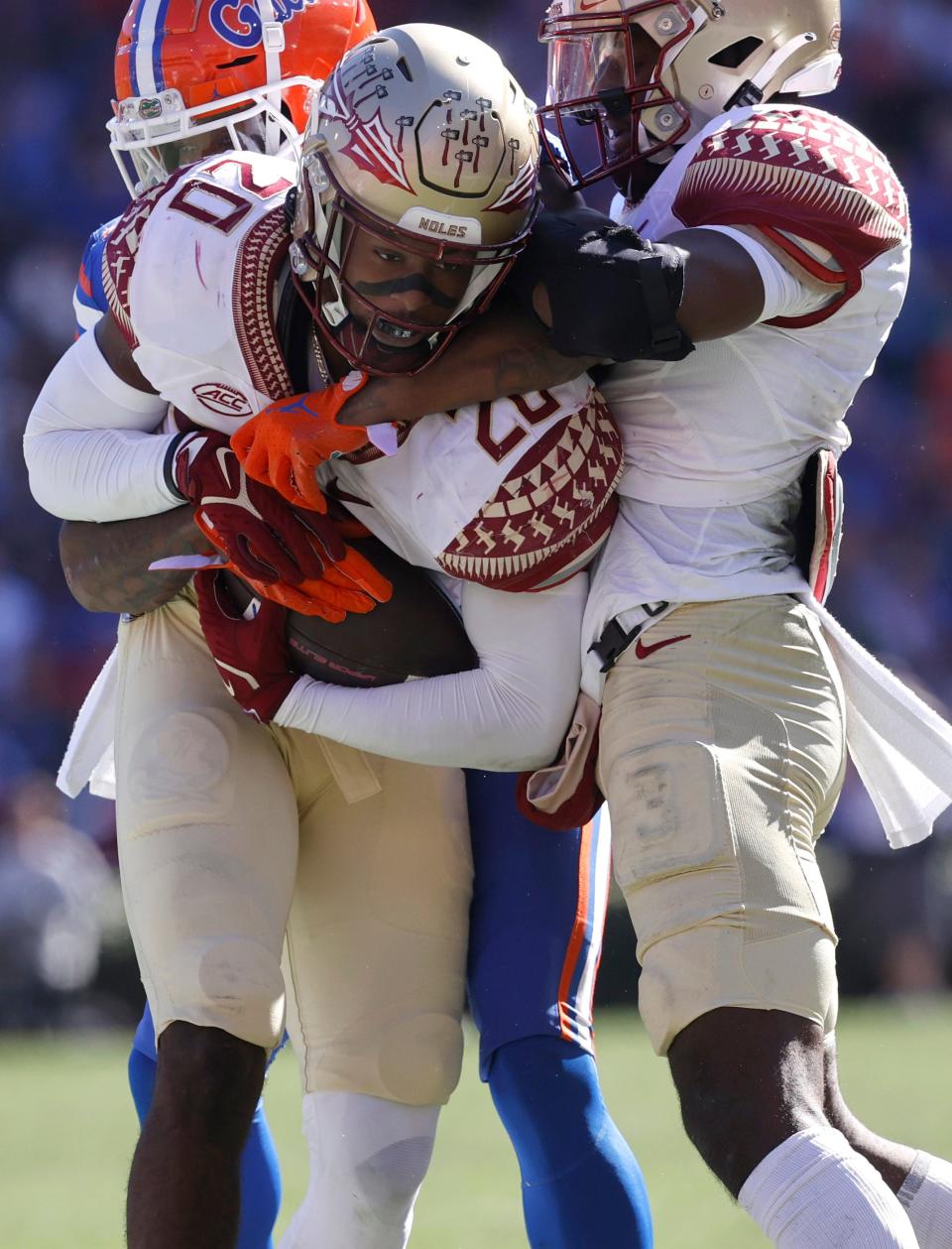By the numbers: How did Florida State football compare statistically over the 2021 season?
- Oops!Something went wrong.Please try again later.
Even though Florida State's season finished Saturday, this feels like as good a time as any for some reflection.
The Seminoles wound up right around their expected season record at 5-7, but did so in an extraordinarily unusual way in head coach Mike Norvell's second season.
What were the keys for the Seminoles' successes and failures?
In what areas did FSU overachieve and underachieve? How could the state of the roster entering the offseason affect the Seminoles entering 2021?
Column on the end of FSU's 2021 season: Despite UF loss, one can't deny FSU's long-awaited positive offseason momentum | Weiler
FSU-UF recap: Three takeaways from FSU football's rivalry loss to Florida Gators
An unfortunate end to Johnson's season: Florida State’s defensive strength neutralized in frustrating loss to the Florida Gators
Those answers and more as we dig into how FSU stacks up compared with the rest of the country with one final look inside the numbers.
Offense (Rank out of 130 FBS teams)
Points per game: 27.6 (73)
Yards per play: 5.79 (69)
Yards per rush: 4.78 (41)
Yards per pass attempt: 7.1 (83)
First downs per game: 20.8 (72)
Third down conversion percentage: 34.9 (104)
Red zone conversion percentage: 90.5% (20)
Red zone touchdown percentage: 73.8% (7)
Sacks allowed per game: 3.0 (113)
Plays gaining 10-plus yards: 166 (68)
Time of possession: 28:19 (105)
Analysis: In the end, FSU was above middling in just a few offensive categories.
The Seminoles' coaching staff did what they could, but an untalented group of receivers, a rotation of quarterbacks at times due to injuries and an offensive line group without much depth all proved too much to overcome consistently.
The run game was a major strength early on as FSU ran for over five yards per carry in six of their first seven games. The Seminoles failed to do that even once in their final five games as the defenses got tougher, coming closest against Florida with 4.33 yards per carry.
While Jordan Travis showed significant growth as the season progressed, it seems clear he needs better talent and more experience around him in order for him to grow into the player he's capable of becoming. That FSU's offense was as productive as it was this season is in large part due to him.

Travis' 86.6 grade this season per Pro Football Focus was sixth-best among ACC quarterbacks in a loaded year for the conference at the position. He graded out better than NC State's Devin Leary, Boston College's Phil Jurkovec and both Miami quarterbacks D'Eriq King and Tyler Van Dyke.
It does bear mentioning that after scoring on all three red-zone trips against UF, the Seminoles end the 2021 season having scored points the last 32 times they got inside the opponent's 20-yard line.
Defense
Points per game allowed: 26.5 (70)
Yards per play allowed: 5.18 (36)
Yards per rush allowed: 3.62 (34)
Yards per pass attempt allowed: 7.0 (44)
First downs per game allowed: 20.4 (66)
Third down conversion percentage allowed: 41.3 (94)
Red zone conversion percentage allowed: 70.6% (6)
Red zone touchdown percentage allowed: 61.8% (87)
Sacks per game: 2.75 (33)
Plays gaining 10-plus yards allowed: 166 (68)
Analysis: FSU's defensive improvement, especially as the season progressed, was remarkable.
Aided by a few transfer additions and the developments of a few younger players, the Seminoles' defense finished the regular season 38th in ESPN's defensive SP+ rankings. This after the Seminoles were 95th in defensive SP+ in 2020 and 83rd in defensive SP+ three weeks into the 2021 season.
Yes, FSU will have to replenish some of those key losses like defensive ends Jermaine Johnson and Keir Thomas either through the transfer portal, high school recruiting or development of the roster. But there will also be some returning pieces who have shown signs of growth like linebacker Kalen DeLoach and defensive tackle Malcolm Ray and some young players who the staff can build around like defensive backs Kevin Knowles II and Omarion Cooper.
It remains to be seen what next year's defense looks like, but there were enough promising signs to feel at least somewhat optimistic about the unit heading into the offseason.
Special teams
Field goal percentage: 76.9% (62)
Yards per punt: 42.7 (63)
Yards per punt return: 4.2 (118)
Yards per kickoff return: 20.4 (65)
Analysis: No doubt that special teams was the Seminoles' most disappointing unit considering how much improved they were in Norvell's first season and how much time FSU spends on them in practice.
FSU kicker Ryan Fitzgerald finished strong, making 7 of his final 8 field goals. However, he attempted just five over the Seminoles' final five games, four of which came in one game against Miami.
While FSU punter Alex Mastromanno didn't have the strongest finish to his second season vs. Florida, he finished the 2021 season with no touchbacks on 61 punts, 18 of which were downed inside the 20-yard line.
FSU's kick returns were not incredible this season, but it was the punt return unit that especially drew ire. The Seminoles consistently lost hidden yardage over the season by letting punts land and also had a few mistakes fielding them. Four different Seminoles got in-game reps as a punt returner this season and none of them proved to be the solution.
The identification of new options, either through the portal or the incoming high school class, will be something to watch this offseason.
Miscellaneous
Turnover margin: -1 (75)
Penalties per game: 6.9 (93)
Penalty yards per game: 62.5 (102)
Analysis: It's pretty unbelievable that FSU put itself in such a bad turnover margin hole (-6 through three games) that the Seminoles still finished in the negative despite being +7 over their final seven games.
FSU's defense had three more interceptions Saturday, giving the Seminoles 12 over their final six games. FSU's streak of eight consecutive games with an interception will be the longest active streak in the country entering the 2021 season.

As for the penalties, a poor finish ruined what had been a promising development in penalty avoidance for the Seminoles. While the officiating in the BC game can be called into question, a number of FSU's penalties against Florida were moments where the Seminoles lost their discipline in a heated rivalry game.
FSU's penalty rankings nationally were the best they had been since 2017 this season, moving past a trio of seasons where FSU was in or near the bottom 10 in the country. But those numbers would have looked a lot better had FSU not racked up over 200 combined yards of penalties in its final two games.
Reach Curt Weiler at cweiler@tallahassee.com or follow him on Twitter @CurtMWeiler.
No one covers the ‘Noles like the Tallahassee Democrat. Subscribe using the link at the top of the page and never miss a moment.
This article originally appeared on Tallahassee Democrat: What were FSU's strengths, weaknesses during 2021 football season?

